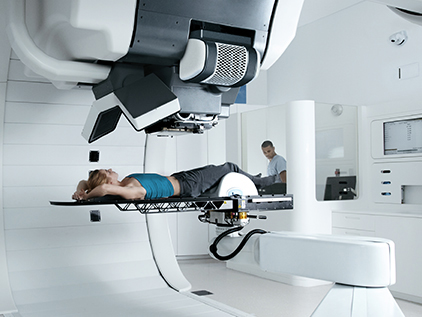- Home
- Types & Treatments
- Head & Neck Cancer
Head and Neck Cancer

The University of Kansas Cancer Center’s nationally recognized head and neck cancer specialists are committed to providing every treatment option available. Using a team approach that leads to better care for head, neck and throat cancers, we can often effectively treat cancers others consider untreatable.
Head and neck cancer is cancer that occurs in any part of the head and neck (except in the case of brain cancer). Primarily seen in men over 50, head and neck cancers are increasingly diagnosed in people under 50, including nonsmokers and nondrinkers who have the human papillomavirus.
Head and neck cancer care overview
Head and neck cancers include those found in the mouth, throat, sinuses, nasal cavity, larynx, salivary glands, thyroid and parathyroid:
- Laryngeal cancer is a disease in which malignant (cancer) cells form in the tissues of the larynx, or voice box. Most laryngeal cancers form in squamous cells, the thin, flat cells in the lining of the larynx.
- Oral cancer, or cancer of the mouth, can develop in any part of the mouth. This includes the lip, front two-thirds of the tongue, gums, insides of the cheeks, floor or roof of the mouth, and the small area behind the wisdom teeth. Most lip and oral cavity cancers start in the squamous cells that line the lips and oral cavity.
- Salivary gland cancer is a rare disease in which malignant (cancer) cells form in the tissues of the salivary glands. More than half of all salivary gland tumors are benign (not cancerous) and do not spread to other tissues.
- The most common type of sinus and nasal cavity cancer is squamous cell carcinoma. This type of cancer forms in the cells that line the inside of the sinuses and the nasal cavity. However, other types of sinus and nasal cavity cancer can include:
- Melanoma: Cancer that starts in cells called melanocytes, the cells that give skin its natural color.
- Sarcoma: Cancer that starts in muscle or connective tissue.
- Inverting papilloma: Benign tumors that form inside the nose. A small number of these change into cancer.
- Midline granulomas: Cancer of the tissues in the middle part of the face.
- Throat cancer includes cancer of the nasopharynx (the upper part of the throat behind the nose), the oropharynx (the middle part of the pharynx) and the hypopharynx (the bottom part of the pharynx). Most throat cancers are squamous cell carcinomas that begin in the squamous cells in the lining of the inside of the throat.


Why choose us for head and neck cancer care
The University of Kansas Cancer Center is among a select few in the country, and the Kansas City region’s only cancer center to earn National Cancer Institute designation.
We take an inclusive approach to helping you and your family navigate through the head and neck cancer diagnosis, treatment and recovery processes. Available services include nutritional counseling, social work, cancer research resources and support groups.
Our rehabilitation specialists help you regain function after treatment and surgery. Speech therapy, swallowing therapy and reconstructive and cosmetic rehabilitation are often part of the treatment for those with head and neck cancer.
As our patient, you’ll also receive access to clinical trials that may provide treatment options not available elsewhere. Clinical trials may study innovative radiation and drug therapies, functional and quality-of-life assessments and supportive care interventions.
Learn more about head and neck cancer

Getting back in the game
Young baseball player James “Hooty” Wade survives a rare head and neck cancer thanks to the expertise of his cancer specialist.
James' story
Start your path today.
Your journey to health starts here. Call 913-588-1227 or request an appointment at The University of Kansas Cancer Center.